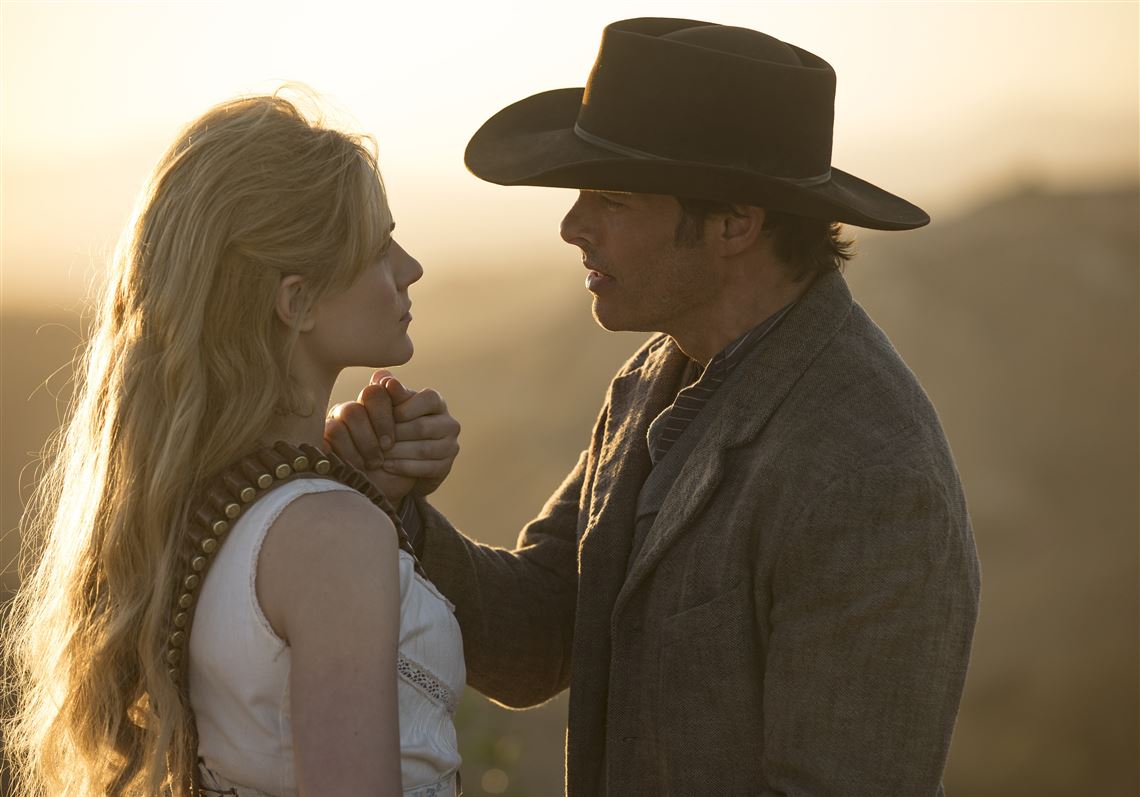Prime-time television has largely been in a dark mood — antiheroes, complicated villains, character deaths, oh my! — since scripted programming came to cable, cemented by critical and popular early hits “The Sopranos” and “The Shield.”
Over the next week we may hit #PeakBleak with a combo platter of the sophomore season premieres of Hulu’s “The Handmaid’s Tale” and HBO’s “Westworld.” “Westworld” is the more repeatedly violent and gory of the pair while “Handmaid’s Tale” comes across as more disturbing because the world it creates actually feels like it could come to pass. Neither program is an easy viewing experience; both shows represent today’s TV at its best.
‘Westworld’
There’s mopping up of last season’s finale in the first couple of episodes of “Westworld” (9 p.m. Sunday). It’s also a little confusing to step back into this series after more than a year since the last original episode. Who can remember all the myriad details about a puzzle-like story?
Set in the future at the Westworld park where humans interact with (re: kill, have sex with) human-like robots, season one ended with the robots turning on their creators in a violent uprising led by programmed-to-be-a-rancher’s-daughter Dolores (Evan Rachel Wood).
The first couple of episodes of season two are particularly bloody as the robot hosts — with new agency and understanding of how they have been used by their human overloards — slaughter park guests.
Early episodes also suffer from an abundance of self-important robot speechifying, particularly from Dolores. Former Old West brothel host Maeve (the excellent Thandie Newton) gives a more interesting, less wantonly violent peek into a robot’s psyche as she searches for her “daughter.”
Then there’s poor Bernard (Jeffrey Wright), revealed in season one to be a robot who works among the humans as a programmer of the Westworld hosts. As the new season begins, he seems to be glitching. Viewers see Bernard at various points in time and it’s not always clear what is in the present or what is in the past or future. Turns out, Bernard isn’t clear on that either (“I can’t tell if this is now or then,” he says in episode four).
It takes a bit for “Westworld” to get back up to full steam, but by episode three (five hours were made available to TV critics), this futuristic, violent drama returns to fine form, introducing new parts of the park (Shogun World!), new characters and apparently new technology goals on the part of Delos, the corporation that owns Westworld.
‘The Handmaid’s Tale’
Based on the novel by Margaret Atwood, “The Handmaid’s Tale” season two (streaming Wednesday) begins right where the first season (and the novel) ended with Offred/June (Elisabeth Moss, “Mad Men”) on her way to either her end or a new beginning. At first it seems like it could be the latter but ultimately devolves back to the former.
Yet through its first six episodes the show avoids rehashing season one and instead moves the characters’ stories forward through flashbacks to the pre-Gilead era. (The one major flashback missing: I really want to know what Aunt Lydia, played by Emmy winner Ann Dowd, was like pre-Gilead.)
Set in a future where America has been taken over by religious fundamentalist conservatives who enslave women and rename the country, “The Handmaid’s Tale” initially focused on Offred in the home of Commander Waterford (Joseph Fiennes) and his wife, Serena (Yvonne Strahovski, “Chuck”). By the end of season one, Offred was pregnant, presumably with the child of the commander’s driver, Nick (Max Minghella).
Season two continues Offred’s journey while also checking in on other characters, including Offred’s best friend, Moira (Samira Wiley), who escaped to Canada and now lives with Offred’s husband, Luke (O-T Fagbenle).
In season two, the show takes viewers to the Colonies, which appear to be a nuclear-devastated wasteland where Offred’s friends, Ofglen (Alexis Bledel, “Gilmore Girls”) and Janine (Madeline Brewer), are enslaved in work camps waiting to die.
There’s a bit of a “Walking Dead” vibe to “Handmaid’s Tale”: Everything is terrible; it’s only getting worse. But because we know from the book that Gilead and its oppressive regime eventually come to ruin, and thanks to the show’s use of “Lost”-style flashbacks to illuminate character and relationships that provide glimpses of humanity, there’s still reason for hope even as season two explores the guilt and shame Offred/June feels in Gilead and felt in her pre-Gilead life. (Actress and 1978 Carnegie Mellon University grad Cherry Jones joins the cast this season in flashbacks as June’s hippie mom who disapproves of what she sees as June’s bourgeois lifestyle.)
Kept/canceled
HBO renewed “Silicon Valley” and “Barry.”
AT&T’s Audience Network renewed the comedy “Loudermilk.”
Comedy Central will bring back “Broad City” for a fifth and final season in 2019.
Netflix renewed “Jessica Jones” for a third season.
Hulu renewed “I Love You, America With Sarah Silverman” and Netflix ordered more “On My Block.”
Channel surfing
The 2003 Erie “pizza bomber heist” gets the Netflix docuseries treatment with the May 11 release of the four-episode “Evil Genius: The True Story of America’s Most Diabolical Bank Heist,” executive produced by Mark and Jay Duplass.
Tuned In online
Today’s TV Q&A column responds to questions about “Shark Tank,” “At Home With Amy Sedaris” and local TV news. This week's Tuned In Journal includes posts on “Bill Nye: Science Guy.” Read online-only TV content at http://communityvoices.post-gazette.com/arts-entertainment-living/tuned-in.
This week’s podcast includes conversation about “Lost in Space,” “Trading Spaces” and Peabody Award nominations. Subscribe or listen to Pittsburgh Post-Gazette podcasts at iTunes or at https://soundcloud.com/pittsburghpg.
TV writer Rob Owen: rowen@post-gazette.com or 412-263-2582. Follow RobOwenTV on Twitter or Facebook for breaking TV news.
First Published: April 19, 2018, 4:35 p.m.
















